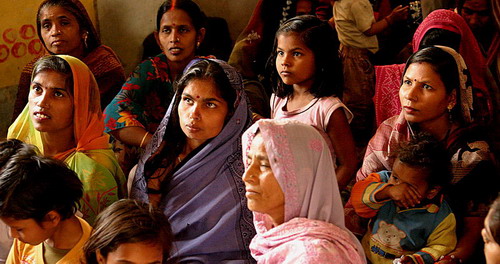Lokarpit Voice: Why?
Our organization works in the northern Indian state of Uttar Pradesh, one of the poorest states in India. The area is predominantly rural and has for centuries been plagued by abject poverty. High birth rates (5-8 children per household) and high infant mortality rates are the norm. There's a severe lack of basic knowledge of maternal health. For example, one of the local traditions is to smear cow dung on a recently cut umbilical cord; another example is the custom of reserving the job of cutting the umbilical cord exclusively to low-caste helpers, and when such helpers need to be fetched from afar, the umbilical cord remains attached for as long as 24 to 48 hours, worsening infection rates. Many of these customs and misconceptions are not widely known or practiced elsewhere so one-size-fits-all "experts" or pamphlets rarely adequately address such misconceptions or concerns.
The problem of lack of such basic awareness and knowledge is badly compounded by the lack of access to basic care. A clinic or hospital is often far away; transportation is difficult to arrange; villagers are concerned about being charged a high fee that they can't afford if they seek care; a conservative culture dictates that most do not feel comfortable about the idea of a woman traveling alone (to seek care) without the company of a husband or father, who are needed in the fields or at other work places (like a brick factory). Due to the difficulty of seeking care, people tend to overlook their illness until it's perceived to be serious. Often, instead of trekking to a district hospital that can be tens of kilometers away, people tend to seek advice from local quacks, who typically end up doing more harm than good. Better access to maternal health information would have helped in preventing and identifying less urgent problems earlier before they worsen.
Traditionally, there are several approaches of addressing maternal health information. Because the qualified doctors, nurses, and organizations who truly understand the local problems are few, the concerned geographical area is large, and the infrastructure (such as roads) is poor, the commonly adopted model is a so-called "cascaded training" model, where the experts train the trainers, the trainers train the next-level trainers, and so on. There is a loss of fidelity and, furthermore, there is a large degree of diversity and complexity of the problems at the local level that, due to the disconnect between the experts and the ones who truly need help, cannot be adequately addressed.
Another theme of approaches that has been tried is to use some form of technology: kiosks equipped with computers, or smart-phone-based solutions, to name just two. The practicality of such solutions is limited due to the cost, usability, and infrastructural issues (such as lack of electricity to power a kiosk or the lack of data network coverage--while voice coverage is pervasive, data coverage isn't). The low literacy rates of the community that we serve further compounds the difficulty of these technology-based solutions. Our experience is that even an SMS-based solution is difficult to make work in this environment.